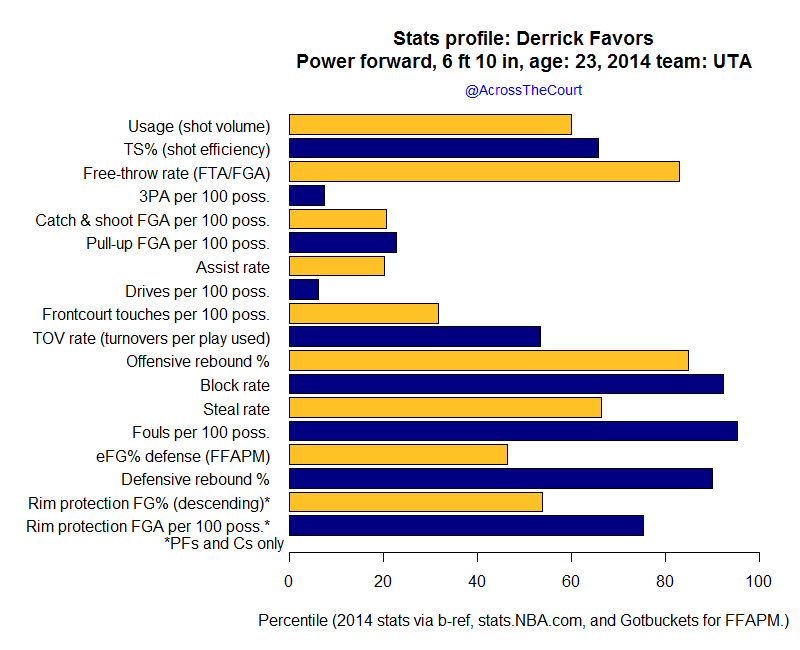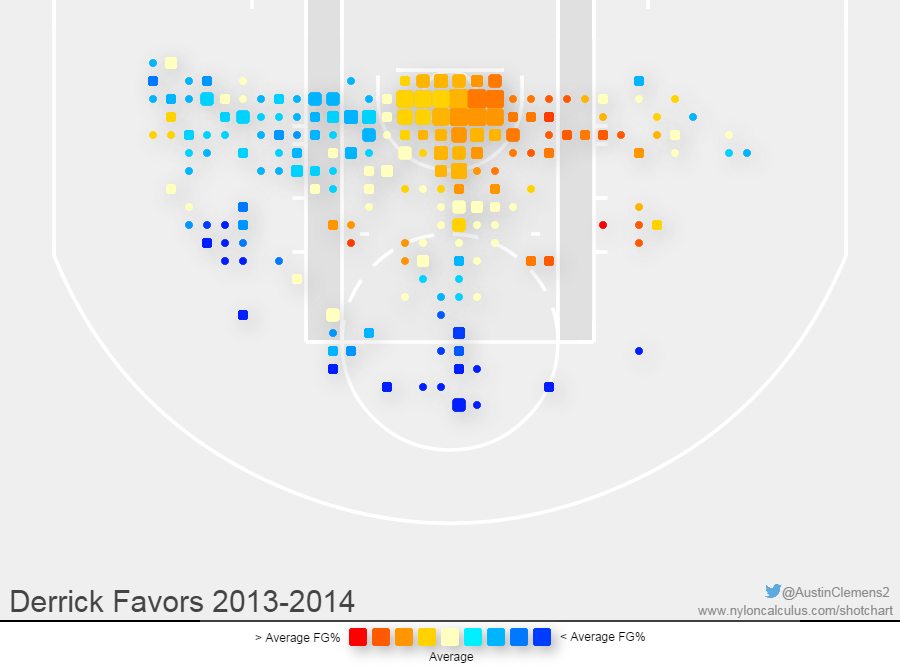The Utah Jazz have a winning tradition, currently ranked fourth all-time in franchise win-loss percentage behind the obvious juggernauts of the Lakers, Celtics, and Spurs, but they suffered through a rebuilding season and a title, elusive even to Malone and Stockton, is far beyond the horizon. They were not content with being mired in mediocre and jettisoned all-star big men Jefferson and Millsap. Utah now belongs to the core of Burke, Hayward, Kanter, and Favors, for better of worse. Tellingly, if they have a repeat of their season the Jazz will likely fall to 7th or 8th all-time in win percentage. The success of their past is fading away, and fans are becoming anxious.
2014 in review
The Jazz started the season 1-14, outscored by 12 a game. However, the team stabilized, likely due to rookie point guard Trey Burke returning from an injury. Without him they were essentially playing without a point guard — and it showed. At the beginning of the season before Burke, they sported a 95.9 offensive rating, over 10 points worse than the league average (that’s historically bad.) Hayward looked pressed as a number one option, as his turnovers ballooned and his shooting efficiency plummeted from above average to significantly below.
But the real issues were on defense. They were just a stone’s throw away from having the worst defense in the league, and a Favors-Kanter frontline was supposed to lead to strong defensive results in the coming years. That’s troubling, but young guys are usually bad on defense and improve with age more than most people think. They didn’t cause turnovers and they could defense shots, but they at least rebounded decently. But as we see with most bad teams, this is partly the intention. They were rebuilding, letting their young guys and and loading up on lottery talent. Not surprisingly, they finished with the worst record in the west.
Changes
Exit: Richard Jefferson, Marvin Williams, John Lucas III, Brandon Rush, Michael Harris, Jamaal Tinsley, Malcolm Thomas, Andris Biedrins.
Enter: Steve Novak, Trevor Booker, Dante Exum, Toure’ Murry, Rodney Hood.
The Jazz are more or less intact given the spirit of the team. Richard Jefferson was never part of their long-term plans, and some guys were holdovers from past deals. (Biedrins is only 28 years old, but his NBA career is probably over and he arguably peaked when he was 21 and shot 24% from the free-throw line over the past five seasons.) Novak and Booker are most likely the two biggest new pieces of their rotation besides the rookie, where Novak’s shooting is an elixir to the range limitations of their big men. Exum, the rookie, came off a disappointing showing in FIBA and is basically like a high school draft pick as he has no professional or college experience: he in fact is coming off a high school title from earlier in the year.
Player spotlight
The future of Utah hinges on its young core, and nowhere is the age and potential dichotomy more glaring than Derrick Favors. He’s tall, mobile, and extremely active, but it has yet to translate into high-level results. The chart below covers a wide range of stats and how his compare to other NBA players with at least 1000 minutes.
Favors’ stats are quite extreme. His activity stats are elite — from his blocks to his steals to rebounding and his ability to draw fouls. No surprise: it hasn’t translated into high-level defense with his mediocre eFG% defense and rim protection FG% values.
The gap near the top of the chart is common for centers: he has few perimeter skills. This is important in projecting his fit next to Enes Kanter, a natural center. Remember, this is relative to every player, so among centers his jump shot rates are not poor, but it does not signify as evidence he works like a stretch 4. Regardless, his usage and efficiency are surprisingly good, and he’s a devastating finisher inside.
He’s not overly reliant on others to create for him either, as his proportion of shots assisted was at the same level as guys like Al Jefferson and Aldridge. But he wasn’t always creating shots in the traditional method: nearly a quarter of his points were second chance points (after an offensive rebound.) And the shot chart below makes his range more visually obvious (via NylonCalculus.) There’s a reason why the Kanter-Favors pairing ran into problems. Favors is a poor shooter, clogging the lane at PF, but he scores exceedingly well near the rim.
His promise lies on defense and his ability to control the boards. For example, I’ve embedded a set of three blocks he had versus the Spurs, stuffing Parker once and Duncan twice (link is also here.)
You can also see his quick hands during a game versus the Bulls.
Favors has to learn the intricacies of NBA defense and fix the typical hyperactivity young big men have, biting on too many fakes and over-committing in general. His post game is still a bit messy, and his mid-range and in-between game is still a work in progress. But his athleticism and good hands will make him one of the most intriguing young frontcourt guys in the league yet again.
2015 projected
The best thing the Jazz have going for them this season is that they’re a group of almost entirely young players. In fact, if it weren’t for my aging curve, they’d have roughly the same strength as last season. Hayward will likely bounce back, and Burke could improve significantly: second year point guards usually do.
Where they’ll be tested is, again, on defense, and on paper this should be workable. A Kanter-Favors frontline appears imposing, and Jeremy Evans as the reserve power forward gives them quickness and some incredible blocked shots. It’s hard to predict when young guys will suddenly understand defense — Tyson Chandler, for instance, was a late bloomer — but improvement even from just one guy would be important. These guys replaced Al Jefferson and the team got worse on defense, which is, fair to say, not a good sign.
But their best defensive player could be Rudy Gobert, who looked more comfortable for France during FIBA, where he helped upset Spain. He’s a truly giant player, and he has the highest recorded standing reach since the measurement has been available. But he’s not a plodding true seven-foot: he’s surprisingly nimble, and his inside presence is special. He blocked the same number of shots per possession as Ibaka did in 2013 and twice as many as Favors.
Novak is an injection of three-point shooting, but they lost Richard Jefferson, who hit 40% and led in makes, and Marvin Williams, who could operate as a stretch 4. The Jazz were already 25th in 3P% and 20th in attempts. Burke and Hayward will need to fix their shooting or spacing issues will be a real concern, as three of their most promising players (Kanter, Favors, and Gobert) are not outside threats. Plus Exum does not come equipped with an NBA outside shot, and on a rebuilding team even if he’s terrible he’s going to get minutes. In place of Burks, a slasher with a usable outside shot, the offense could turn sour.
Every rock bottom team is dreaming they’ll be the next Oklahoma City Thunder, so flush with talent you can give away a young all-star caliber shooting guard and improve on offense. But reality is more boring. They have a strong core of young players, but no one looks like a superstar. Jazz fans are hoping Exum is that guy, but he couldn’t find playing time on a weak FIBA team and we haven’t even seen him in a professional league against high caliber players besides short tournaments.
The optimistic take is that with so many young players, someone could suddenly improve and make the leap, and they end up with more wins than anyone sane would predict. NBA models project that guys improve at smooth, even rates as they age, but in reality they develop in fits and starts. And on a last optimistic note, they’re taking the less crowded route in the west: their conference is absurdly top-heavy and if you’re going to be bad for a few years, now’s the time.
Summary
The frontcourt is crowded and both starters play like centers on offense — I still don’t trust them to cover defense. But Trey Burke and Hayward are real, honest-to-goodness offensive players, and Utah won’t be an embarrassment. The west is so loaded with talented teams finishing last isn’t a black mark. I actually project them with the toughest schedule in the league like last year (mostly because they can’t play themselves, the worst team in the best conference) and they’d net two more wins in the east. Favors could be the key to the season. A young big guy who can create a few shots while blocking and rebounding at high rates is tantalizing, like young Kemp or Anthony Davis, but you could also end up with Tyrus Thomas. It’s that kind of betting that a rebuilding project relies on, and we can’t even predict how long the rebuild will last — sorry about 2015, Jazz fans.
Wins: 26
Losses: 56
Conference rank: 14th (tied)
League offense rank: 23rd
League defense rank: 29th
Edited 10/27/2014






















